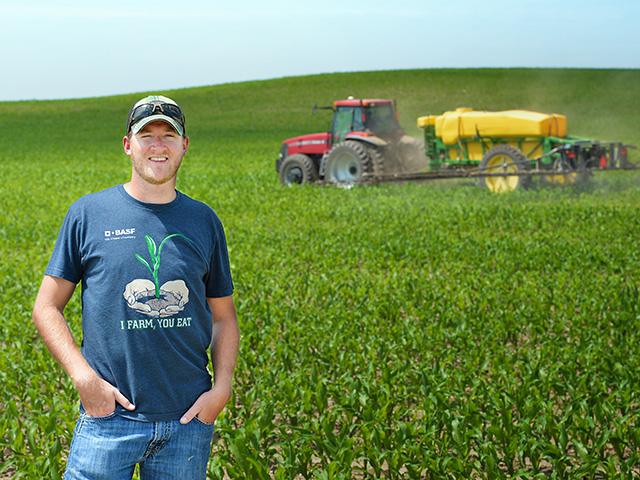This yearlong endeavor looks at how four farmers are evaluating technology and agronomic information that can boost the productivity of their operations.

Landon Aldinger has questions; his fields have answers. While this year's corn and soybeans grow, he's trying out new practices he hopes will enhance productivity and profitability in the years to come.
The Iowa Falls, Iowa, farmer believes one growth opportunity lies in keeping his corn hale and hardy.
Aldinger is zeroing in on best-management practices for corn fungicides. He says an effective fungicide applied at tassel can boost yields, but multiple factors come into play. Beyond the presence and severity of disease, he says there are also hybrid interactions, environmental factors and timing issues.
"Fungicides are a key to maintaining corn health but (application) timing is crucial," says Aldinger, who farms with his father, Mike. "We want to identify hybrids that benefit the most from a fungicide, find the optimum application window and examine cost versus reward of split applications."
Aldinger is working with BASF Innovation Specialist Mike Behrhorst on a trial to answer those and other questions.
"Northern corn blight was a major problem last year, and we saw massive benefits from applying Headline AMP at the tassel stage," Behrhorst notes. "Landon wants to fine-tune his fungicide program to optimize corn health and get a better handle on the economics of a sequential application."
Behrhorst says an application at VT is the biggest "bang for the buck" strategy. There is, however, plenty of evidence that an earlier application, at V5, can help enhance plant health and enhance yield.
"No matter if we are cool and wet, or hot and dry, or any other combination of weather, we see plant health benefits, so we're looking at environmental factors as well as disease issues," he says.
One thing's clear: Corn fungicides aren't as effective on nutrient-challenged soils, and that's another focus.
The variable-rate fertilizer program is expanding on the Aldinger farm to reduce costs and increase efficiency. Grids of 2.5 acres provide the framework, and data from the Aldinger farm and others help formulate nutrient prescriptions.
"We partner with SciMax Solutions to make better informed rate decisions," Aldinger explains. "It is a 'big data' approach, but it's localized and includes our own past yield data, cultural practices, etc."
The Aldingers prefer to apply their total nitrogen (N) as anhydrous ammonia in a single pass. They sidedress additional N if nitrogen loss is suspected or if they have a hybrid with a taste for a late-season snack.
"I planted eight hybrids this year, and I'll treat them all a little differently," Aldinger says. "We see differences across the board in how hybrids respond to everything from fungicides to nitrogen. Some of them love late-season feeding, so we try to treat them individually in order to get the most yield from each."
The family has dealerships for Latham Hi-Tech Seeds and Wyffels Hybrids, and, through their own company, Precision Farm Management, the Aldingers provide information for customers' farms as well as their own.
"One thing I've learned is to pay attention to the ratings and the characteristics of the hybrids," Aldinger says. "Everyone knows they're not all the same, but the important question is, how do you manage a specific hybrid to capture its full yield potential?"
Working with Behrhorst, Aldinger will be looking for new weed-control opportunities this summer. Included will be a full-field trial of the recently launched herbicide Armezon PRO to address some of the farm's specific weed-control needs.
"For conventional corn, we want to identify a better way to control grasses without glyphosate," Aldinger says. "We had a trial last year, and the new herbicide looked good, so we've expanded that this year."
Armezon PRO is a postemergence herbicide for broadleaf and grass control. It's particularly effective on waterhemp, a target weed for Aldinger.
"We do a lot of scouting, and I feel our weed-control program has been pretty good; but you have to stay on top of new products, because that's where our improvement will come from," he says.
And improvement, the young farmer knows, is a crop that needs to be harvested each year.